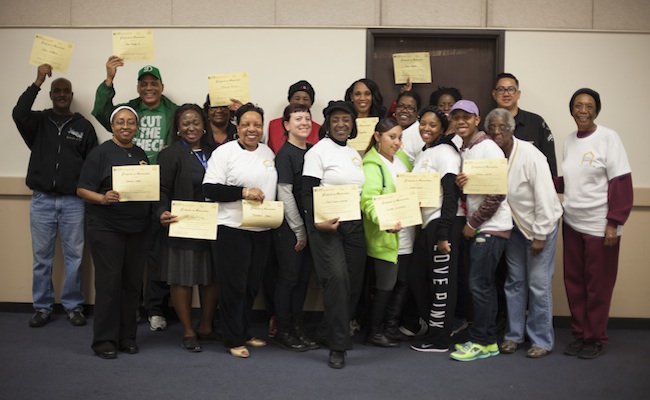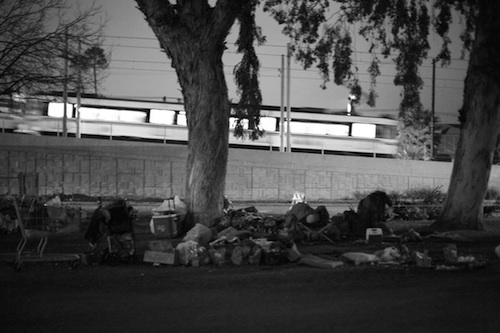
Homeless Count volunteers show their certificates of completion. | Stephanie Monte
Instead of the usual dinner and birthday cake, Jacquelyn Dupont-Walker spent her birthday in a more altruistic way: She gathered a group of family and friends to volunteer for the biennial Homeless Count on Thursday night. The “Happy Birthday Jackie” group joined nearly 100 volunteers at Holman United Methodist Church, one of South L.A.’s deployment sites for the count. This South L.A. contingent represented a fraction of the 6,000 volunteers who gathered data on the city’s homeless population over three days under the supervision of the Los Angeles Homeless Services Authority.
“We want to be a part of the 2015 revived mission to eliminate homelessness,” Dupont-Walker said. “We think this is a part of it.”
L.A.’s Homeless Count is the nation’s largest program taking a headcount of people living on the streets. L.A.’s homeless population is second in size only to the homeless population of New York City.
Homelessness in South L.A. is more common than any other part of the county. The 2013 Homeless Count tallied more than 11,000 homeless people in South L.A. Six of the seven other districts counted a significantly smaller homeless population, with estimates ranging from 2,500 homeless to 8,000. Service Planning Area 4, Metro Los Angeles including Skid Row, with about 10,500 homeless individuals was the only area with an estimate similar to South L.A.’s Area 6.
Photos by Stephanie Monte
In addition to getting an estimate of the number of homeless individuals, the count aims to record the estimated ages of homeless people observed by volunteers and also take note of where they reside.
Volunteers arrived at 8 p.m. on Thursday to begin their training. A presenter instructed them on where to look — parks, alleys and freeway underpasses — and what to look for – people sleeping on benches, car windows covered for privacy or shopping carts stacked with belongings. They were only expected to mark what they saw, the team leaders instructed them not to interact with the people they encountered.
“To count the homeless you are going to have to do more than this,” said deployment site coordinator Tori Bailey, and looked quickly back and forth from left to right.
She elicited a chuckle from the crowd, but they got the more serious part of the message: The count was meant to be non-intrusive but thorough. Precision mattered. Federal and city funding for the homeless population in South L.A. for the next two years depends on the accuracy of this count.
The U.S. Department of Housing and Urban Development requires a biennial Homeless Count to collect data on the homeless population. Non-profit organizations and service providers then use these numbers to apply for programming so they can better serve the needs of their individual communities.

Homeless encampment at Rancho Cienega Park in South L.A. | Stephanie Monte
After an hour-long training session, the volunteers broke into groups of three to four. They departed from the church to cover a designated portion of a South L.A. U.S. Census tract. Using a tally sheet, they spent several hours jotting down notes about people who appeared homeless, noting the cars, vans or tents that individuals appeared to be using for shelter.
Denise Burgher volunteered for the first time this year after she heard about the opportunity through her church, Bryant Temple AME. She has done other types of homeless outreach in the past, such as passing out clothing or food on Skid Row. But to her, these actions were not the most effective way to make a difference. She joined the Homeless Count this year in hopes of helping to implement systematic change.
“This felt like an organized, sensible, practical way to make a contribution,” Burgher said. “I hope that if we are able generate an accurate count, then the positive consequence will be that we will have enough money to affect good programming.”
Intersections South L.A. reporter Anna-Cat Brigida attended the Homeless Count as volunteers set out and Stephanie Monte documented the counting process. Listen to Stephanie’s audio interviews with volunteers below.
___________________________________________________
Like Intersections on Facebook, follow us on Twitter and sign up for the Newsletter to stay in the loop on news and views from South L.A. Email reporter Anna-Cat Brigida at [email protected] and Stephanie Monte at [email protected]. Follow them @AnnaCat_Brigida and @sublime_stephy.















Speak Your Mind